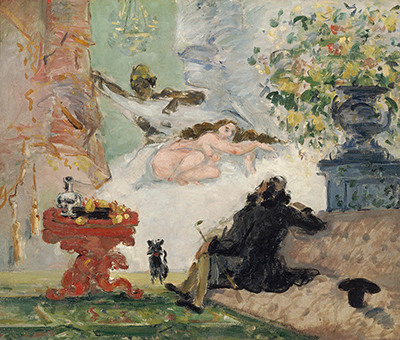In 1863, Eduard Manet painted Olympia. When displayed, this provocative painting caused instant scandal, thanks to a number of details which identified the central nude figure as a prostitute.
Ten years later, Paul Cézanne was inspired to creat his own Modern Olympia, a direct response to Manet's scandalous work. In fact, this 1873 piece is Cézanne's second version of A Modern Olympia. It features bright, luminous colours, and shows a clear movement towards Impressionism. As an Impressionist piece, this work - made in oil on canvas - seems rough, almost like a draft, with skittish brush strokes casually depicting the characters of the painting. Perhaps unsurprisingly, given its style, this painting was produced very quickly, in the manner of a sketch.
This was unusual for Cézanne, who in his later career became known for his perfectionism and the time that he spent over each painting, to ensure a precise result. Indeed, the sketch-like brush strokes led some contemporary critics to compare this painting to the work of a madman, and suggest that Cézanne had painted it while in a state of delirium. As well as its Impressionist style, A Modern Olympia is notable for its contrasting colours. Like Manet's work, Cézanne's features a white nude and a black servant. His servant has a lighter skin tone than Manet's, though.
This gives more room for contrast, as he has chosen to include a third figure. A man dressed in black sits, facing away from the viewer and towards the central woman. His black clothes contrast starkly with the pale skin of the nude, and the white bedding on which she reclines. Many people see the figure of Cézanne himself in this male spectator, who observes without joining the scene. Although the style of the painting has little in common with Manet's Olympia, the subject matter is identical. Like Manet's work, Cézanne's painting caused a stir when it was displayed for the first time, in 1874.
Looking at it now, it is an interesting example of Cézanne's Impressionist period. It does not contain any of the techniques that would later become the artist's hallmarks as, in his later period, he became better known for his precise still life paintings, with a heavy emphasis on geometric accuracy. This painting, therefore, may be seen as something of an experiment for Cézanne. Today, A Modern Olympia can be seen in Cézanne's native France. It forms part of the permanent collection in the Musée d'Orsay in Paris, where it can be seen alongside many other works by the artist.




